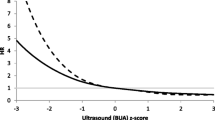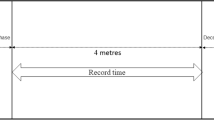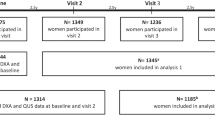Abstract:
In this cross-sectional study we investigated the relationship between ultrasound measurements in the calcaneus versus daily physical activity and fractures sustained in the past in elderly subjects. Ultrasound measurements were performed at both heels, which enabled us to examine determinants of differences between contralateral heels. Participants were 132 men and 578 women, aged 70 years and over (mean age and standard deviation (SD): 83 ± 6 years), living in homes for the elderly (n= 343) or apartment houses for the elderly (n= 367). Broadband ultrasound attenuation (BUA) and speed of sound (SOS) were measured in the right and left calcaneus. The median difference (and interquartile range) between the two heels for BUA and SOS, expressed as a percentage of the mean value for each individual, was 9.6% (4.2–15.7%) and 1.0% (0.4–1.7%), corresponding to 25% and 40% of the study population SD, respectively. Greater differences in BUA between the two heels were associated with variables indicating poorer functional status, such as past fractures at the lower extremities. The level of daily physical activity was obtained by means of a questionnaire regarding household and leisure activities. Subsequently sumscores were calculated for daily physical activity and a subscore indicating weight-bearing physical activity. After adjustment for age, gender, residence, and body weight, physical activity scores were positively linearly related to both BUA and SOS. Each 5 point increase on the weight-bearing physical activity score, corresponding to, for example, walking for 2.5 h per week, was associated with a difference in BUA of 4.7 dB/MHz and in SOS of 5.1 m/s, which is similar to the differences associated with 10 kg higher body weight, or 10 years younger age. After the age of 50 years, 47 subjects had fractured a hip, 61 subjects had sustained another lower extremity fracture, 104 subjects a wrist fracture, and 62 subjects another upper extremity fracture. After adjusting for age, gender and residence, odds ratios for all fracture types in the lowest terciles of BUA and SOS versus the highest terciles ranged from 1.9 to 3.8. This study showed significant differences in ultrasound measurements between the left and the right heel, indicating that measurements at both sides are necessary for optimal evaluation of bone strength. Furthermore, after careful adjustments, ultrasound parameters had higher values with higher daily physical activity in elderly subjects and discriminated subjects with a history of fracture from those without.
Similar content being viewed by others
Author information
Authors and Affiliations
Additional information
Received: 26 June 1997 / Accepted: 1 February 1998
Rights and permissions
About this article
Cite this article
Graafmans, W., Bouter, L. & Lips, P. The Influence of Physical Activity and Fractures on Ultrasound Parameters in Elderly People. Osteoporos Int 8, 449–454 (1998). https://doi.org/10.1007/s001980050090
Issue Date:
DOI: https://doi.org/10.1007/s001980050090




